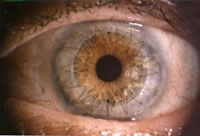 The cornea is the outermost layer of the eye and also the clear part of the eye that covers the iris, pupil and anterior chamber. Just like a clear window, the cornea is critical in maintaining a sharp focus on objects, playing a role in overall focusing power. The inside layer of the cornea, the endothelium, has a finite number of cells that maintain clarity and do not regenerate.
The cornea is the outermost layer of the eye and also the clear part of the eye that covers the iris, pupil and anterior chamber. Just like a clear window, the cornea is critical in maintaining a sharp focus on objects, playing a role in overall focusing power. The inside layer of the cornea, the endothelium, has a finite number of cells that maintain clarity and do not regenerate.
If you have been recently diagnosed with a diseased or damaged cornea, or have severe keratoconus you can get a better understanding of your medical condition from the text that follows. If you are seeking a cornea transplant in Omaha, Dr. Liu can help put you on the road to better vision. This website text below is for informative purposes only. Please consult a medical doctor for a specific diagnosis if you have corneal problems.
Understanding the Cornea
The cornea represents the very front surface of the eye or the outer surface of the eye. The cornea plays a major role in how you focus on images. In conjunction with your natural crystalline lens, the natural lens, the cornea helps to provide required focusing power. If the cornea becomes weak or damaged serious problems may arise. Because the cornea is such an important part of your visual system please make sure to contact a qualified ophthalmologist if you think you might have damaged your cornea. It is not uncommon for our office to see and treat damaged corneas. Treating the cornea with medication is typically the first thing that the doctors will try. If your vision cannot be accurately corrected with medications, eyeglasses or contact lenses a corneal transplant may be required.
How does damage to the Cornea occur?
Damage to the cornea may arise from various reasons such hereditary issues, chemical burns, blunt object trauma, viruses, bacteria or fungal infections as well as autoimmune disorders. Conditions that may require a patient seek a cornea transplant involve clouding of the cornea, keratoconus, Fuchs dystrophy, irregular corneal surface tissue growths or corneal swelling.
What is a Corneal transplant?
A corneal transplant, also known as a corneal graft or as penetrating keratoplasty, involves the removal of the central portion (called a button) of the diseased cornea and replacing it with a matched donor button of the cornea. Corneal grafts are performed on patients with damaged or scarred corneas that prevent acceptable vision. This may be due to corneal scarring from disease or trauma. In this photo of a recent transplant, the stitches can be seen clearly on the right side.
A common indication for keratoplasty is keratoconus. The eye-care practitioner must decide when to recommend keratoplasty for the keratoconic patient. This is often not a simple, straight-forward decision. Keratoplasty for keratoconus is highly successful; however, there is a long recovery period and a risk of severe ocular complications. A number of factors must be considered in deciding when to do a keratoplasty.
One of the most important is the patient’s functional vision. If the best acuity with their contact lenses prevents them from doing their job or carrying out their normal activities, a transplant must be considered. The actual measured visual acuity may be quite different for different patients. One patient may find that he or she can not do their job with 20/30 acuity while another patient may be very satisfied with 20/60 acuity.
Very careful contact lens fittings are necessary before recommending a corneal transplant. One study found that 69% of keratoconus, most referred for transplant, could be successfully fit with contact lenses if special lens designs were used. Thus, prior to transplant, every effort should be made to optimally fit the patient with contact lenses, especially if there is not significant corneal scarring affecting vision.
However, a few patients become intolerant to contact lenses and require a transplant earlier than otherwise would be necessary. If the patient has a large area of thinning, a very decentered cone or significant blood vessel growth into the usually clear cornea, called neovascularization, a transplant may be performed earlier than otherwise indicated by the visual performance, as these factors may require a larger than normal transplant button size and increase the chance of rejection if allowed to advance too far.
Patients Need a Corneal Transplant When:
- Vision is not good enough to perform daily activities.
- There is pain or recurring infections in the damaged cornea
Healing After Corneal Transplant
The healing process following transplant is long, often taking a year or longer. The time from surgery to the removal of the stitches is commonly 6 to 17 months. The patient may be on steroids for months. Initially, following surgery, the donor button is swollen and the button is usually thicker than the corneal bed in which it rests. The photo on the left shows a thick white ring of scarring between the donated button and the patient’s outer cornea. The white radial marks are where stitches were placed to hold the transplant in position.


